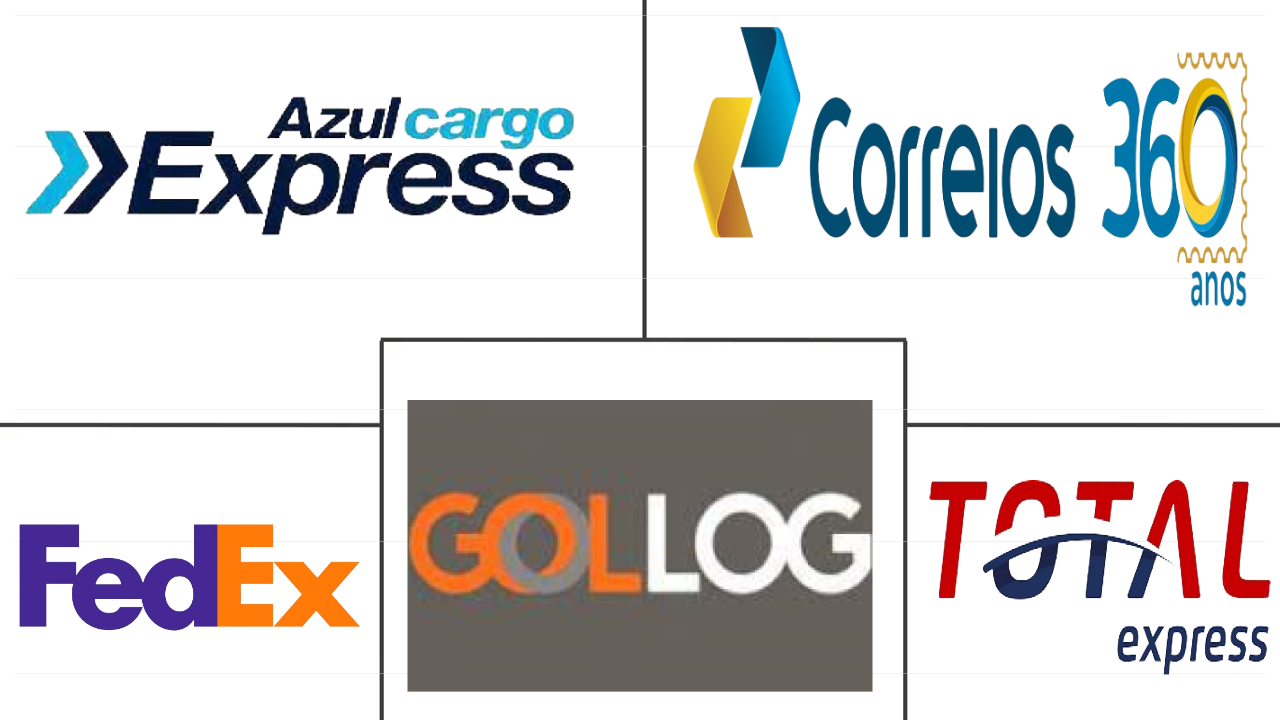Market Size of brazil courier, express, and parcel (cep) Industry
| Icons | Lable | Value |
|---|---|---|
|
|
Study Period | 2017 - 2030 |
|
|
Market Size (2024) | USD 3.17 Billion |
|
|
Market Size (2030) | USD 4.41 Billion |
|
|
Largest Share by Destination | Domestic |
|
|
CAGR (2024 - 2030) | 5.66 % |
|
|
Fastest Growing by Destination | International |
|
|
Market Concentration | Medium |
Major Players |
||

|
||
|
*Disclaimer: Major Players sorted in no particular order |
Brazil Courier, Express, and Parcel (CEP) Market Analysis
The Brazil Courier, Express, and Parcel (CEP) Market size is estimated at 3.17 billion USD in 2024, and is expected to reach 4.41 billion USD by 2030, growing at a CAGR of 5.66% during the forecast period (2024-2030).
3.17 Billion
Market Size in 2024 (USD)
4.41 Billion
Market Size in 2030 (USD)
3.83 %
CAGR (2017-2023)
5.66 %
CAGR (2024-2030)
Fastest Growing Market by Speed of Delivery
6.55 %
Projected CAGR, Express, 2024-2030
Various international parcel delivery partners dominate the express delivery segment, further supported by service expansions and strategic partnerships.
Fastest Growing Market by Model
7.35 %
Projected CAGR, Business-to-Consumer (B2C), 2024-2030
The B2C segment is generating significant parcel demand due to the country's increasing domestic and cross-border e-commerce.
Largest Market by Shipment Weight
69.91 %
value share, Light Weight Shipments, 2023
Fashion items, toiletries, perfumery and cosmetic products, and consumer electronics are some of the major goods driving delivery demand in the segment.
Largest Market by End User Industry
41.87 %
value share, Manufacturing, 2023
The manufacturing sector is expected to grow in the coming years due to the implementation of Industry 4.0 technologies such as automation, artificial intelligence, and machine learning.
First leading Market player
38.51 %
market share, Empresa Brasileira de Correios e Telegrafos, 2022

Empresa has over 6,000 agencies in Brazil available to support its express shipping services, with a presence in more than 5,000 municipalities in Brazil.
E-commerce is driving the domestic and international CEP demand
- E-commerce user penetration is projected to reach 66.7% by 2027. Cross-border e-commerce demand is thus pushing companies to expand CEP services. For instance, Cainiao, a logistics company of Alibaba expanded in the CEP market in 2022. The company launched its first parcel distribution center in Brazil, which is a significant addition to its regional network of sorting centers. The company aims to utilize and expand infrastructure for intra-city and cross-border logistics services and grocery deliveries. The company currently operates 8 weekly chartered flights between China and Brazil and plans to add more air and sea routes between the countries.
- In 2020, Brazil Post was the leading parcel courier based on the number of parcels delivered in Brazil. The Brazilian postal service provider held over half of the parcel shipping market, with a 51% market share in the country in 2020. However, in 2020, Brazil Post lost both parcel volume and revenue market share to competitors. The top six carriers in Brazil accounted for 71% of the country’s parcel shipments by volume. Brazil Post saw the biggest decrease in market share by revenue from 54% in 2019 to 39% of the market in 2020 and by volume from 66% in 2019 to 51% in 2020.
- E-commerce was a major driver for domestic and international CEP market growth and demand in the country in 2021. The electronics segment was the most popular e-commerce segment in terms of the total number of orders, followed by fashion, personal and household care, toys, hobby and DIY, and furniture . With e-commerce projected to reach USD 71.68 billion by 2027, the CEP market is expected to grow exponentially.
Brazil Courier, Express, and Parcel (CEP) Industry Segmentation
Domestic, International are covered as segments by Destination. Express, Non-Express are covered as segments by Speed Of Delivery. Business-to-Business (B2B), Business-to-Consumer (B2C), Consumer-to-Consumer (C2C) are covered as segments by Model. Heavy Weight Shipments, Light Weight Shipments, Medium Weight Shipments are covered as segments by Shipment Weight. Air, Road, Others are covered as segments by Mode Of Transport. E-Commerce, Financial Services (BFSI), Healthcare, Manufacturing, Primary Industry, Wholesale and Retail Trade (Offline), Others are covered as segments by End User Industry.
- E-commerce user penetration is projected to reach 66.7% by 2027. Cross-border e-commerce demand is thus pushing companies to expand CEP services. For instance, Cainiao, a logistics company of Alibaba expanded in the CEP market in 2022. The company launched its first parcel distribution center in Brazil, which is a significant addition to its regional network of sorting centers. The company aims to utilize and expand infrastructure for intra-city and cross-border logistics services and grocery deliveries. The company currently operates 8 weekly chartered flights between China and Brazil and plans to add more air and sea routes between the countries.
- In 2020, Brazil Post was the leading parcel courier based on the number of parcels delivered in Brazil. The Brazilian postal service provider held over half of the parcel shipping market, with a 51% market share in the country in 2020. However, in 2020, Brazil Post lost both parcel volume and revenue market share to competitors. The top six carriers in Brazil accounted for 71% of the country’s parcel shipments by volume. Brazil Post saw the biggest decrease in market share by revenue from 54% in 2019 to 39% of the market in 2020 and by volume from 66% in 2019 to 51% in 2020.
- E-commerce was a major driver for domestic and international CEP market growth and demand in the country in 2021. The electronics segment was the most popular e-commerce segment in terms of the total number of orders, followed by fashion, personal and household care, toys, hobby and DIY, and furniture . With e-commerce projected to reach USD 71.68 billion by 2027, the CEP market is expected to grow exponentially.
| Destination | |
| Domestic | |
| International |
| Speed Of Delivery | |
| Express | |
| Non-Express |
| Model | |
| Business-to-Business (B2B) | |
| Business-to-Consumer (B2C) | |
| Consumer-to-Consumer (C2C) |
| Shipment Weight | |
| Heavy Weight Shipments | |
| Light Weight Shipments | |
| Medium Weight Shipments |
| Mode Of Transport | |
| Air | |
| Road | |
| Others |
| End User Industry | |
| E-Commerce | |
| Financial Services (BFSI) | |
| Healthcare | |
| Manufacturing | |
| Primary Industry | |
| Wholesale and Retail Trade (Offline) | |
| Others |
Brazil Courier, Express, and Parcel (CEP) Market Size Summary
The Brazil Courier, Express, and Parcel (CEP) market is experiencing significant growth, driven by the increasing penetration of e-commerce and the demand for cross-border logistics services. The expansion of CEP services is evident with companies like Cainiao, a logistics arm of Alibaba, establishing parcel distribution centers in Brazil to enhance their regional network. This growth is further supported by the Brazilian government's efforts to improve infrastructure through privatization and investment in logistics, including airports and transportation systems. Despite challenges such as high logistics costs and fuel price fluctuations, the market is poised for expansion, with major players like Azul Cargo Express, FedEx, and Total Express actively investing in operational enhancements and international shipping capabilities.
The Brazilian CEP market is moderately consolidated, with a few key players dominating the landscape. The market's growth is closely tied to the booming e-commerce sector, which is expected to reach substantial figures in the coming years. The electronics segment leads in e-commerce orders, followed by fashion and other categories, fueling the demand for efficient parcel delivery services. The market dynamics are also influenced by regulatory changes and economic factors, such as fuel pricing policies and tax adjustments, which impact logistics costs. As the market evolves, companies are focusing on strategic partnerships and infrastructure development to capture a larger share of the growing demand for courier, express, and parcel services in Brazil.
Brazil Courier, Express, and Parcel (CEP) Market Size - Table of Contents
-
1. MARKET SEGMENTATION (includes Market Value in USD, Forecasts up to 2030 and analysis of growth prospects)
-
1.1 Destination
-
1.1.1 Domestic
-
1.1.2 International
-
-
1.2 Speed Of Delivery
-
1.2.1 Express
-
1.2.2 Non-Express
-
-
1.3 Model
-
1.3.1 Business-to-Business (B2B)
-
1.3.2 Business-to-Consumer (B2C)
-
1.3.3 Consumer-to-Consumer (C2C)
-
-
1.4 Shipment Weight
-
1.4.1 Heavy Weight Shipments
-
1.4.2 Light Weight Shipments
-
1.4.3 Medium Weight Shipments
-
-
1.5 Mode Of Transport
-
1.5.1 Air
-
1.5.2 Road
-
1.5.3 Others
-
-
1.6 End User Industry
-
1.6.1 E-Commerce
-
1.6.2 Financial Services (BFSI)
-
1.6.3 Healthcare
-
1.6.4 Manufacturing
-
1.6.5 Primary Industry
-
1.6.6 Wholesale and Retail Trade (Offline)
-
1.6.7 Others
-
-
Brazil Courier, Express, and Parcel (CEP) Market Size FAQs
How big is the Brazil Courier, Express, and Parcel (CEP) Market?
The Brazil Courier, Express, and Parcel (CEP) Market size is expected to reach USD 3.17 billion in 2024 and grow at a CAGR of 5.66% to reach USD 4.41 billion by 2030.
What is the current Brazil Courier, Express, and Parcel (CEP) Market size?
In 2024, the Brazil Courier, Express, and Parcel (CEP) Market size is expected to reach USD 3.17 billion.

